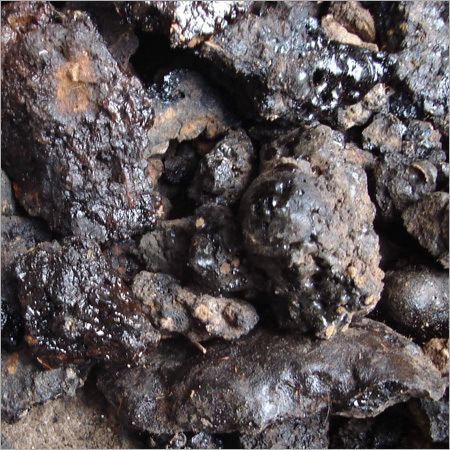 | ||
Shilajit (Sanskrit: शिलाजतु, śilājatu) is a thick, sticky tar-like substance with a colour ranging from white to dark brown (the latter is more common), is found predominately in Himalaya and Tibet mountains, Caucasus mountains, Altai Mountains, and mountains of Gilgit Baltistan Pakistan.
Contents
It is used in Ayurveda, the traditional Indian system of medicine. It has been reported to contain at least 85 minerals in ionic form, as well as triterpenes and humic acids.
Terminology
Shilajit comes from the Sanskrit compound word shilajatu meaning "rock-conqueror", which is the regular Ayurveda term. It is also spelled shilajeet (Hindi: शिलाजीत) and salajeet (Urdu: سلاجیت).
Shilajit is known universally by various other names, such as mineral pitch or mineral wax in English, black asphaltum, Asphaltum punjabianum in Latin, also locally as shargai, dorobi, barahshin, baragshun (Mongolian: Барагшун), mumlai (Farsi مملایی), tasmayi (Kazakh: тасмайы), brag zhun (Tibetan: བྲག་ཞུན་), chao-tong, wu ling zhi (Chinese: 五灵脂, which generally refers to the excrement of flying squirrels), baad-a-ghee (Wakhi for "devil's feces"), and arkhar-tash (Kyrgyz: архар-таш). The most widely used name in the former Soviet Union is mumiyo (Russian: мумиё, variably transliterated as mumijo, mumio, momia, and moomiyo), which is ultimately from Persian mūmiyā (مومیا).
Origin
Several researchers have noted that Shilajit is unlike mineral tar seeps and is most likely of vegetable origin. The cactus like plant Euphorbia royleana has been observed growing near collection sites and is suggested as a likely origin as its gum has a similar composition.
History
Shilajit is found predominately in Himalaya, Tibet mountains, Altai and Caucasus mountains. The color range varies from a yellowish brown to pitch-black, depending on composition. For use in Ayurvedic medicine the black variant is considered the most potent. Shilajit has been described as 'mineral oil', 'stone oil' or 'rock sweat', as it seeps from cracks in mountains due mostly to the warmth of the sun. There are many local legends and stories about its origin, use and properties, often wildly exaggerated. It should not be confused with ozokerite, also a humic substance, similar in appearance, but apparently without medicinal qualities. In fact, neither of the substances, ozokerite nor shilajit, possesses any scientifically proven medicinal qualities.
Once cleaned of impurities and extracted, shilajit is a homogeneous brown-black paste-like substance, with a glossy surface, a peculiar smell and bitter taste. Dry shilajit density ranges from 1.1 to 1.8 g/cm3. It has a plastic-like behavior, at a temperature lower than 20 °C/68 °F it will solidify and will soften when warmed. It easily dissolves in water without leaving any residue, and it will soften when worked between the fingers.
It is still unclear whether shilajit has a geological or biological origin as it has numerous traces of vitamins and amino acids. A shilajit-like substance from Antarctica was found to contain glycerol derivatives and was also believed to have medicinal properties.
Based on currently available studies, the bioactivity of shilajit lacks substantial evidence. The immuno-modulatory activity does not stand the test of critical assessment and is considered as unproven.
Shilajit has been the subject of scientific research in Russia and India since the early 1950s. In the former USSR, medical preparations based on mumiyo/shilajit are still being sold, further developed and investigated.
